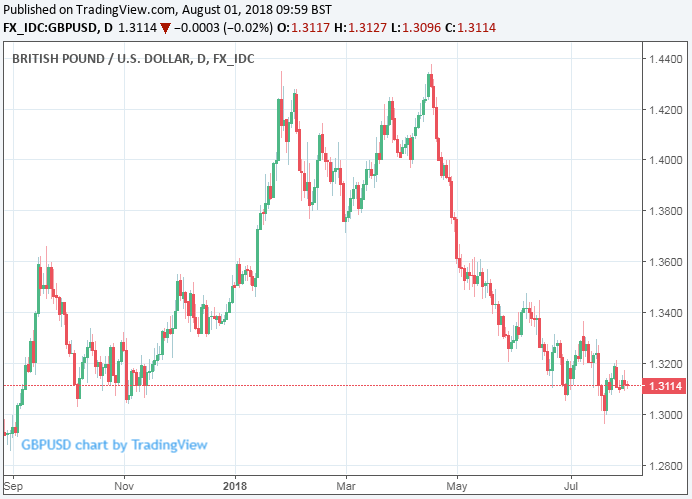Traders Shun Sterling as UK Manufacturing Activity Slows, BoE Decision Looms
- Written by: James Skinner
- British Pound eases lower after IHS Markit Manufacturing PMI disappoints.
- Slower production and new order growth drive fall in July PMI index.
- Data comes as traders shun GBP ahead of crunch BoE decision.

© freepeoplea, Adobe Stock
Pound Sterling eased lower Wednesday after July's IHS Markit manufacturing PMI left traders with little incentive to place big bets on the currency ahead of the Bank of England (BoE) interest rate decision due Thursday.
The IHS Markit manufacturing PMI fell to 54.0 for July, down from 54.4 in June, when the market consensus had been for a more modest decline to 54.2.
The mismatch between expectations and the actual outcome is miniscule but it is deviation against expectations that moves currency markets.
The Pound was quoted 0.05% lower against the US Dollar at 1.3120 following the release and is down 2.85% for 2018, while the Pound-to-Euro exchange rate was unchanged at 1.1224.

Above: Pound-to-Euro rate shown at daily intervals.
Despite the data missing expectations, the index still rests comfortably above its long-term average of 51.8, the data was enough to leave the British currency treading water.
Both output and new order growth slowed during the July month, contributing most of the fall in the index, as a slowdown in new order growth from the domestic market more than offset an uptick in new export orders and hampered production growth.
A slower pace of orders for intermediate goods, which are components used in the process of manufacturing other finished products, was the primary driver behind the downturn in July. Investment goods producers and the consumer goods industry both fared relatively well during the month.
"The output balance (which has the best relationship with the official figures) posted a larger decline, from 55.3 to 54.0. But that still leaves it consistent with quarterly growth in manufacturing output of 0.3%, which would be a substantial improvement on the 1.2% 3m/3m contraction in the latest hard data for May," says Andrew Wishart, an economist at Capital Economics.
PMI surveys measure changes in industry activity by asking respondents to rate conditions for employment, production, new orders, prices, deliveries and inventories. A number above the 50.0 level indicates industry expansion while a number below is consistent with contraction.
"The sub balances suggest that neither the possibility of a no deal exit from the EU in March nor the threat of an escalation in EU-US trade tensions have weighed on the sector. Indeed, the export orders balance rose from 54.0 to 54.7, suggesting that the sector is still benefiting from the weaker pound and robust global demand," says Wishart.
Markets care about the data because, covering the UK's three largest commercial sectors, they are an important indicator of momentum within the economy. And economic growth has direct bearing on the rate of inflation and it is consumer price pressures that dicate where interest rates, which are the raison d'être for most moves in exchange rates, will go next.

Above: Pound-to-Dollar rate shown at daily intervals
"Optimism about the outlook for output over the next 12 months dropped in July to its lowest level since October 2016. Admittedly, manufacturers’ pessimism might reflect fears that the U.S.-E.U. trade war would escalate, which they might no longer hold. Note that the survey was conducted between July 12 and 26, largely before President Trump and Jean-Claude Junker agreed to de-escalate the trade war on July 25," says Samuel Tombs, chief UK economist at Pantheon Macroeconomics.
Manufacturing has been a relative bright spot for the UK economy ever since the Brexit vote of June 2016, with the double digit fall in the Pound making British goods cheaper for overseas customers to buy, while a robust domestic economy has also fuelled demand.
This saw industrial firms experience eight consecutive quarters of output growth in the period to the end of 2017, marking the longest expansion for the sector since 1988, although momentum has waned recently. The IHS PMI has fallen from 58.2 in November 2017 to 54.0 in July 2018.
"Past form suggests that the boost to growth in manufacturing output from sterling’s 2016 depreciation will continue to fade over the coming months. Accordingly, the manufacturing sector likely will just tread water in the second half of this year," Tombs concludes.
Meanwhile, the outlook for the economy is clouded after GDP growth fell by half during the first quarter to just 0.2%, down from 0.4% at the end of 2017. Data released so far suggests the economy rebounded in the second quarter, although most expect an annual expansion of only 1.5% for 2018 overall, which would be down from the 1.7% seen in 2017.
The first-quarter economic slowdown, and a steep decline in UK inflation, led the Bank of England (BoE) to abandon the idea of an interest rate rise in May. This dented the Pound and left markets looking to the August meeting for the next possible move.
The Bank is widely expected by the market to raise UK interest rates to 0.75%, which would be only the second increase since the 2008 financial crisis, despite that consumer price inflation has fallen much faster this year than it or almost any economist had forecast.
Advertisement
Get up to 5% more foreign exchange by using a specialist provider to get closer to the real market rate and avoid the gaping spreads charged by your bank when providing currency. Learn more here




